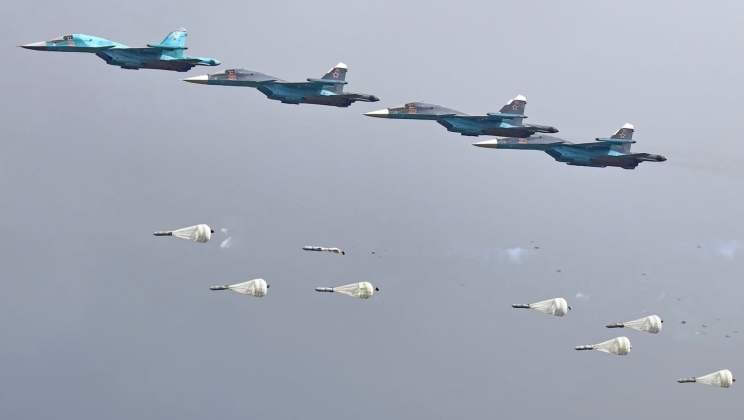News
Russian Su-34 Strike Fighters Use Guided Glide Bombs to Neutralise Ukrainian Army Units Around Kupyansk
The Russian Air Force has deployed Su-34 strike fighters to launch precision strikes against Ukrainian infantry and armoured units near Kupyansk, according to a report by the Russian Defence Ministry on February 26. The aircraft used high diameter glide bombs with precision guidance, including the ability to correct course during flight. The ministry highlighted that the bombs’ glide capabilities allowed Su-34s to launch strikes from beyond the range of enemy air defences, with all Su-34s returning to base after the attack. The use of glide bombs places aircraft at much lower risk than conventional gravity bombs, which must be dropped from considerably closer to the target, providing a far less costly alternative to using air launched cruise or ballistic missiles which have traditionally been relied on to stay clear of enemy air defences. Precision guidance not only allows such bombs to destroy targets much more efficiently, cutting the number of sorties required significantly, but it also allows bombs to be dropped from higher altitudes where not only are aircraft safer from infrared guided short ranged ground based air defence systems, but their bombs can also fly considerably further up to 70 kilometres.

The Su-34 has a particularly high endurance, meaning it not only has longer range than any other fighter class in the world, but can also carry payloads more comparable to those of early nuclear armed bombers than modern fighters. It has been a primary workhorse of the Russian Air Force since the outbreak of hostilities in Ukraine, with Western sources estimating that approximately two dozen have been lost over the two year campaign – an average of around one aircraft per month. All have been lost either to accidents or to ground based anti aircraft assets. The increasingly widespread use of glide bombs by the Russian Air Force was highlighted with growing concern by Western and Ukrainian sources in 2023, with the Russian defence sector having significantly expanded its capacity to produce such munitions. Ukrainian Air Force spokesman Colonel Yuri Ignat warned on May 2 regarding the threat these weapons posed: “Those bombs can fly about 70 kilometres (about 43 miles) and they may target the facilities of critical infrastructure, kindergartens, residential areas and educational and medical institutions and we cannot counter this type of ammunition. Our air defence is inefficient against the bombs themselves but we should rather try to down the Su-34 [strike fighter] carriers of this ammunition.”

Multiple Ukrainian personnel in January 2024 informed the New York Times that a new wave of Russian air strikes using glide bombs imposed “additional devastating power,” supplementing that from near constant artillery attacks since the spring. They stressed that these bombs carried up to 500kg of explosives each and could thus obliterate their underground bunkers. One serviceman compared the impact of Russian glide bomb strikes to “hell’s gates,” stressing that the Russian Air Force “would send them two by two by two, eight in an hour… It sounds like a jet coming down on you.” Ukraine’s inability to provide support with manned combat aircraft, other than those deploying foreign sourced long ranged cruise missiles which are highly scarce, has left its ground forces at a significant disadvantage supplementing the growing discrepancies in artillery and ballistic missile assets favouring Russian forces. Russia’s latest class of glide bomb the PBK-500U Drel is set to enter production on a large scale before the end of the year, and will likely make its combat debut in the theatre. Production of the Su-34 strike fighter is also reported to have been expanded from 2023, with airframes delivered from mid 2022 being built to the enhanced Su-34M standard.












